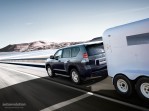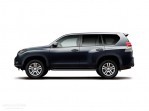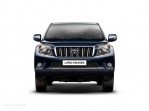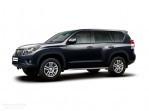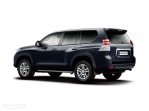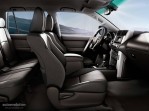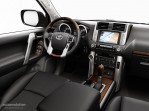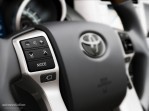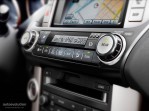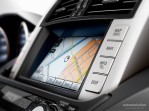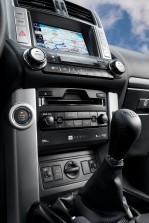Body style: SUV (Sports Utility Vehicle)
Segment: Medium SUV
Production years: 2009, 2010, 2011, 2012, 2013
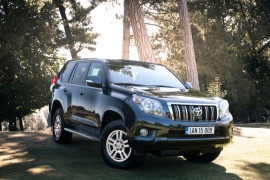 96 Photos
96 PhotosToyota continued the Land Cruiser saga with a new generation in 2009. Even if it did look like a facelift for its predecessor, it was a new vehicle.
The Land Cruiser had already started to forget its hard-core off-roading skills and adopted a front independent suspension ever since 1996. Even though that led to shorter wheel travel in off-road situations, it also made the car more comfortable during daily use. And that increased the sales.
At the front, the fourth generation of the Land Cruiser/Prado showed a new front fascia fitted with a chromed grille with vertical double-slats. Its headlights didn't sport that rugged look from its predecessors. Instead, they were swept back towards the upper sides of the front fenders. From its profile, the five-door version looked more balanced than its three-door sibling. It was longer and featured an extended wheelbase, making room for the rear doors. At the back, since now they had enough room, the automaker's engineers deleted the spare wheel from the rear door tailgate and moved in underneath the vehicle.
Inside, the Land Cruiser provided plenty of room for five adult passengers, with two bucket seats at the front and three on the split-folding bench in the back. The carmaker also offered a seven-seat option for selected markets, with two additional jump-seats in the trunk. The dashboard design was inspired by regular cars with a driver-oriented layout. Toyota installed the infotainment unit underneath the center rectangular vents atop the center stack.
Under the hood, Toyota installed a choice of gasoline and turbo-diesel engines, depending on the market. All of them were available with either a six-speed manual or a five-speed automatic, with manual mode. It sent the power in all corners via a two-speed transfer case.
TOYOTA Land Cruiser 150 5 Doors 2009, 2010, 2011, 2012, 2013
- 4.0L V6 5AT AWD (282 HP)
- 5.7L V8 6AT AWD (381 HP)
- 3.0L D-4D 5AT AWD (190 HP)
- 3.0L D-4D 6MT AWD (173 HP)
- 3.0L D-4D 6MT AWD (190 HP)
TOYOTA Land Cruiser 150 5 Doors
4.0L V6 5AT AWD (282 HP)
ENGINE SPECS - 4.0L V6 5AT AWD (282 HP) | |
|---|---|
| Cylinders: | V6 |
| Displacement: | 3956 cm3 |
| Power: | 207 KW @ 5600 RPM 281 HP @ 5600 RPM 278 BHP @ 5600 RPM |
| Torque: | 285 lb-ft @ 4400 RPM 386 Nm @ 4400 RPM |
| Fuel System: | Multi-port Injection |
| Fuel: | Gasoline |
| Fuel capacity: | 23 gallons (87.1 L) |
PERFORMANCE SPECS | |
|---|---|
| Top Speed: | 112 mph (180 km/h) |
| Acceleration 0-62 Mph (0-100 kph): | 9.2 s |
TRANSMISSION SPECS | |
|---|---|
| Drive Type: | All Wheel Drive |
| Gearbox: | 5-speed automatic |
BRAKES SPECS | |
|---|---|
| Front: | Ventilated Discs |
| Rear: | Ventilated Discs |
TIRES SPECS | |
|---|---|
| Tire Size: | 265/60 R18 |
DIMENSIONS | |
|---|---|
| Length: | 187.4 in (4760 mm) |
| Width: | 74.2 in (1885 mm) |
| Height: | 72.6 in (1844 mm) |
| Front/rear Track: | 63.2/63.2 in (1,605/1,605 mm) |
| Wheelbase: | 109.8 in (2789 mm) |
| Ground Clearance: | 8.7 in (221 mm) |
| Cargo Volume: | 32.1 cuFT (909 L) |
| Aerodynamics (Cd): | 0.35 |
WEIGHT SPECS | |
|---|---|
| Unladen Weight: | 4685 lbs (2125 kg) |
FUEL ECONOMY (NEDC) | |
|---|---|
| City: | 16 mpg US (14.7 L/100Km) |
| Highway: | 27.3 mpg US (8.6 L/100Km) |
| Combined: | 21.7 mpg US (10.8 L/100Km) |
| CO2 Emissions: | 256 g/km |
TOYOTA Land Cruiser 150 5 Doors
5.7L V8 6AT AWD (381 HP)
ENGINE SPECS - 5.7L V8 6AT AWD (381 HP) | |
|---|---|
| Cylinders: | V8 |
| Displacement: | 5663 cm3 |
| Power: | 280 KW @ 5600 RPM 381 HP @ 5600 RPM 375 BHP @ 5600 RPM |
| Torque: | 401 lb-ft @ 3600 RPM 544 Nm @ 3600 RPM |
| Fuel System: | Multi-port Injection |
| Fuel: | Gasoline |
TRANSMISSION SPECS | |
|---|---|
| Drive Type: | All Wheel Drive |
| Gearbox: | 6-speed electronically controlled automatic overdrive with intelligence (ECT-i), sequential shift mode and uphill/downhill logic |
BRAKES SPECS | |
|---|---|
| Front: | Ventilated Discs |
| Rear: | Ventilated Discs |
TIRES SPECS | |
|---|---|
| Tire Size: | 285/60R18 |
DIMENSIONS | |
|---|---|
| Length: | 187.4 in (4760 mm) |
| Width: | 74.2 in (1885 mm) |
| Height: | 72.6 in (1844 mm) |
| Front/rear Track: | 63.2/63.2 in (1,605/1,605 mm) |
| Wheelbase: | 109.8 in (2789 mm) |
| Ground Clearance: | 8.7 in (221 mm) |
| Cargo Volume: | 32.1 cuFT (909 L) |
| Aerodynamics (Cd): | 0.35 |
WEIGHT SPECS | |
|---|---|
| Unladen Weight: | 5690 lbs (2581 kg) |
| Gross Weight Limit: | 7275 lbs (3300 kg) |
FUEL ECONOMY (NEDC) | |
|---|---|
| City: | 13 mpg US (18.1 L/100Km) |
| Highway: | 18 mpg US (13.1 L/100Km) |
TOYOTA Land Cruiser 150 5 Doors
3.0L D-4D 5AT AWD (190 HP)
ENGINE SPECS - 3.0L D-4D 5AT AWD (190 HP) | |
|---|---|
| Cylinders: | L4 |
| Displacement: | 2982 cm3 |
| Power: | 139.7 KW @ 3400 RPM 190 HP @ 3400 RPM 187 BHP @ 3400 RPM |
| Torque: | 302 lb-ft @ 1600-3000 RPM 409 Nm @ 1600-3000 RPM |
| Fuel System: | Common Rail |
| Fuel: | Diesel |
| Fuel capacity: | 23 gallons (87.1 L) |
TRANSMISSION SPECS | |
|---|---|
| Drive Type: | All Wheel Drive |
| Gearbox: | 5-Speed Automatic |
BRAKES SPECS | |
|---|---|
| Front: | Ventilated Discs |
| Rear: | Ventilated Discs |
TIRES SPECS | |
|---|---|
| Tire Size: | 245/70 R17 |
DIMENSIONS | |
|---|---|
| Length: | 187.4 in (4760 mm) |
| Width: | 74.2 in (1885 mm) |
| Height: | 72.6 in (1844 mm) |
| Front/rear Track: | 63.2/63.2 in (1,605/1,605 mm) |
| Wheelbase: | 109.8 in (2789 mm) |
| Ground Clearance: | 8.7 in (221 mm) |
| Cargo Volume: | 32.1 cuFT (909 L) |
| Aerodynamics (Cd): | 0.35 |
| Turning circle: | 38.7 ft (11.8 m) |
WEIGHT SPECS | |
|---|---|
| Unladen Weight: | 4564 lbs (2070 kg) |
| Gross Weight Limit: | 6592 lbs (2990 kg) |
FUEL ECONOMY (NEDC) | |
|---|---|
| City: | 24.2 mpg US (9.7 L/100Km) |
| Highway: | 33.1 mpg US (7.1 L/100Km) |
| Combined: | 29 mpg US (8.1 L/100Km) |
| CO2 Emissions: | 213-209 g/km |
TOYOTA Land Cruiser 150 5 Doors
3.0L D-4D 6MT AWD (173 HP)
ENGINE SPECS - 3.0L D-4D 6MT AWD (173 HP) | |
|---|---|
| Cylinders: | L4 |
| Displacement: | 2982 cm3 |
| Power: | 127 KW @ 3400 RPM 173 HP @ 3400 RPM 170 BHP @ 3400 RPM |
| Torque: | 302 lb-ft @ 1600-2800 RPM 409 Nm @ 1600-2800 RPM |
| Fuel System: | Common Rail |
| Fuel: | Diesel |
| Fuel capacity: | 23 gallons (87.1 L) |
PERFORMANCE SPECS | |
|---|---|
| Top Speed: | 109 mph (175 km/h) |
| Acceleration 0-62 Mph (0-100 kph): | 12.4 s |
TRANSMISSION SPECS | |
|---|---|
| Drive Type: | All Wheel Drive |
| Gearbox: | 6-Speed manual |
BRAKES SPECS | |
|---|---|
| Front: | Ventilated Discs |
| Rear: | Ventilated Discs |
TIRES SPECS | |
|---|---|
| Tire Size: | 245/70 R17 |
DIMENSIONS | |
|---|---|
| Length: | 187.4 in (4760 mm) |
| Width: | 74.2 in (1885 mm) |
| Height: | 72.6 in (1844 mm) |
| Front/rear Track: | 63.2/63.2 in (1,605/1,605 mm) |
| Wheelbase: | 109.8 in (2789 mm) |
| Ground Clearance: | 8.7 in (221 mm) |
| Cargo Volume: | 32.1 cuFT (909 L) |
| Aerodynamics (Cd): | 0.35 |
| Turning circle: | 38.7 ft (11.8 m) |
WEIGHT SPECS | |
|---|---|
| Unladen Weight: | 4751 lbs (2155 kg) |
FUEL ECONOMY (NEDC) | |
|---|---|
| City: | 22.2 mpg US (10.6 L/100Km) |
| Highway: | 32.2 mpg US (7.3 L/100Km) |
| Combined: | 27.7 mpg US (8.5 L/100Km) |
| CO2 Emissions: | 224 g/km |
TOYOTA Land Cruiser 150 5 Doors
3.0L D-4D 6MT AWD (190 HP)
ENGINE SPECS - 3.0L D-4D 6MT AWD (190 HP) | |
|---|---|
| Cylinders: | L4 |
| Displacement: | 2982 cm3 |
| Power: | 139.7 KW @ 3400 RPM 190 HP @ 3400 RPM 187 BHP @ 3400 RPM |
| Torque: | 302 lb-ft @ 1600-3000 RPM 409 Nm @ 1600-3000 RPM |
| Fuel System: | Common Rail |
| Fuel: | Diesel |
| Fuel capacity: | 23 gallons (87.1 L) |
PERFORMANCE SPECS | |
|---|---|
| Top Speed: | 109 mph (175 km/h) |
| Acceleration 0-62 Mph (0-100 kph): | 11.7 s |
TRANSMISSION SPECS | |
|---|---|
| Drive Type: | All Wheel Drive |
| Gearbox: | 6-Speed manual |
BRAKES SPECS | |
|---|---|
| Front: | Ventilated Discs |
| Rear: | Ventilated Discs |
TIRES SPECS | |
|---|---|
| Tire Size: | 245/70 R17 |
DIMENSIONS | |
|---|---|
| Length: | 187.4 in (4760 mm) |
| Width: | 74.2 in (1885 mm) |
| Height: | 72.6 in (1844 mm) |
| Front/rear Track: | 63.2/63.2 in (1,605/1,605 mm) |
| Wheelbase: | 109.8 in (2789 mm) |
| Ground Clearance: | 8.7 in (221 mm) |
| Cargo Volume: | 32.1 cuFT (909 L) |
| Aerodynamics (Cd): | 0.35 |
| Turning circle: | 38.7 ft (11.8 m) |
WEIGHT SPECS | |
|---|---|
| Unladen Weight: | 4542 lbs (2060 kg) |
| Gross Weight Limit: | 5732 lbs (2600 kg) |
FUEL ECONOMY (NEDC) | |
|---|---|
| City: | 24 mpg US (9.8 L/100Km) |
| Highway: | 32.2 mpg US (7.3 L/100Km) |
| Combined: | 28.7 mpg US (8.2 L/100Km) |
| CO2 Emissions: | 217-214 g/km |




